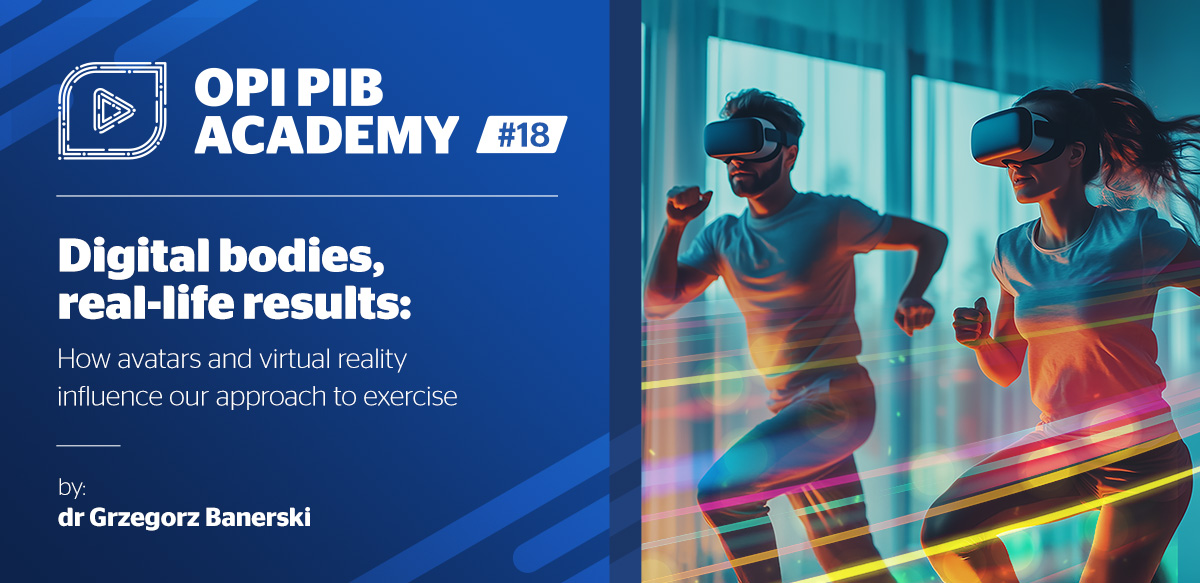Experts at the National Information Processing Institute (OPI PIB) have been analyzing the impact of virtual reality (VR) and ‘digital trainers’, also known as avatars, on people’s attitudes toward physical activity. Research results are very promising.
The role of emotions in physical activity
Experts at OPI PIB formulated a series of research questions. The researchers sought to determine whether remote training formats, such as virtual reality workouts or the now-common screen-based workouts, could influence emotional attitudes toward physical activity. The study also examined whether individuals would find training with a virtual avatar trainer as motivating as training with a real one. The experts also analysed the factors that shape emotional attitudes to exercise. The study prioritised affective attitudes, based on earlier findings which highlighted the importance of emotional states in predicting regular exercise behaviour. Models that integrate emotions focus on short-term goals, such as satisfaction during the workout. When a workout is perceived as enjoyable and energizing, it increases the likelihood of continued participation. Consistent positive experiences during physical activity can foster regular engagement, ultimately contributing to the attainment of long-term objectives such improved health or physical appearance.
Avatar trainers and VR
‘I am glad that experts at OPI PIB continue the exploration of virtual reality. This technology demonstrably influences users’ attitudes. At OPI PIB we have already examined the potential of virtual reality in emergency alerts, remote conferences, teamwork, empathy enhancement, and identification of VR users based on body movement — which directly pertains to privacy in VR systems. This current focus of our research is the application of VR in motivating individuals to engage in physical activity. The results are promising, and it is certainly worth continuing the research,’ says Dr Jarosław Protasiewicz, Head of OPI PIB.
In their study, researchers at OPI PIB implemented a fifteen-minute high-intensity interval training (HIIT) session which involved fifteen intense exercises alternated with short low-intensity exercises. The training programme and recordings were prepared in collaboration with professional trainers. Animated avatars were created which emulated trainers’ movements. A dedicated VR app was developed for training at home. Researchers used a special platform to manage experimental conditions and track study participants’ workout progress. They also prepared an electronic questionnaire to measure attitudes before, during, and after training sessions. Participants were assigned to one of four experimental conditions (screen + avatar, screen + human, VR + avatar, and VR + human). Each group included twenty-five participants, and the trainer’s gender matched that of the participant. VR participants were recruited from VR-related Facebook groups and used their own equipment. They were required to complete six training sessions over fourteen days, with the first three sessions in the first seven days. Following each session, they completed a questionnaire to give their feedback. After completing all sessions, the participants filled out the same attitude questionnaire which they had completed before the first session. The goal was to identify whether the series of workouts had changed participants’ attitudes.
Virtual reality encourages to people to exercise
‘The results revealed that only the participants in the VR conditions demonstrated a significant shift in affective attitude — regardless of whether the participants trained with a human or an avatar. What mattered was where participants exercised, not with whom. In the case of the participants who trained with a human, only the VR group demonstrated a positive change in attitude toward workout. The same was true for the participants working out with avatars — a positive shift was recorded only in the VR group, says Dr Grzegorz Banerski, assistant professor at OPI PIB. Interestingly, the type of trainer didn’t matter. In both environments, the type of trainer had no impact on exercise attitudes. This suggests that VR avatars can act as effective substitutes for human trainers,’ adds Dr Banerski.
It is important to note that initially both VR groups showed a less enthusiastic — sometimes even negative — attitudes toward physical activity than the screen-training groups. However, after completing the training sessions, their attitudes significantly improved and reached the same level as those training in front of a screen. By the end of the training, the affective attitudes towards exercise in all groups were marginally above neutral.
Enjoying your workout is key to achieving optimal results
In conclusion, feeling good while exercising and having a favorable initial attitude were the strongest predictors of positive affective change. The better the participants felt, the greater the positive change. The biggest improvements were seen in those who initially had the most negative attitudes.
Interestingly, a close relationship with the trainer — even a virtual one — and a high self-assessment of competence played particularly important roles in enhancing well-being during the workout. This shows that the relational factor — even with an avatar — matters and is worth exploring further. Perceived fatigue after the workout and the sense of presence in the training environment — whether VR or a flat screen — were less important for shaping the workout experience. Well-being during sessions depended more on the sense of competence and the quality of the relationship with the trainer. This pattern carries over from the real world into digital workout environments, even when an avatar is involved.
Watch the latest episode of the OPI PIB Academy on the OPI PIB’s YouTube channel to learn more about the study:
